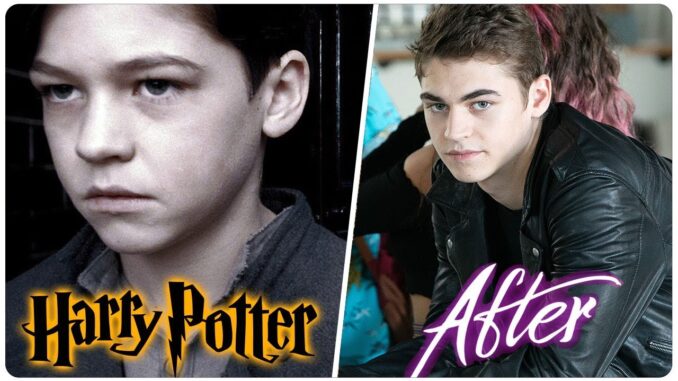
When it comes to captivating transformations on screen, few young actors have navigated such dramatically different roles as Hero Fiennes Tiffin. Best known for portraying the young Tom Riddle in Harry Potter and the Half-Blood Prince (2009) and later rising to global fame as Hardin Scott in the After series (2019–2023), Tiffin’s journey through film has spanned genres, emotions, and character depths. Though these roles come from completely different cinematic universes—one fantasy, one romance—they offer fascinating contrasts in tone, personality, and performance style.
The Beginnings: A Dark Glimpse into the Wizarding World
Hero Fiennes Tiffin was only 11 years old when he was cast as young Tom Riddle, the boy who would eventually become Lord Voldemort, the most feared dark wizard in the Harry Potter universe. His role, though brief, was chilling. In the film, Tiffin portrays an orphaned boy living in a gloomy London orphanage, already showing signs of cruelty, manipulation, and eerie intelligence. Despite his limited screen time, he left a strong impression on audiences. There’s something deeply unsettling in the way he delivers lines with cold detachment, hinting at the darkness to come.
Critics praised his ability to capture the sinister essence of young Riddle, and many noted how perfectly he resembled Ralph Fiennes—his real-life uncle—who played the adult Voldemort. His performance was subtle, yet effective. There were no explosions or dramatic breakdowns. Instead, his menace came from a cold stare, a quiet voice, and a calculated demeanor. It was the perfect embodiment of evil, even in its infancy.
A New Generation’s Bad Boy: Hardin Scott in After
Fast forward a decade, and Hero Fiennes Tiffin reintroduced himself to the world—not as a wizard, but as the smoldering, troubled heartthrob of the After series. As Hardin Scott, a British literature student with a tortured soul and a dangerous charm, Tiffin quickly gained a massive fan base. Adapted from Anna Todd’s bestselling novels, the After films dive deep into a chaotic, passionate relationship between Hardin and Tessa, played by Josephine Langford.
Unlike his emotionless portrayal of Tom Riddle, Hardin Scott is all emotion—anger, pain, love, jealousy, guilt. Tiffin had to tap into a wide range of feelings to bring Hardin to life. He wasn’t just playing a “bad boy”; he was playing a deeply wounded young man, shaped by trauma, loss, and toxic patterns. While some critics found the films melodramatic, fans appreciated the raw chemistry between the two leads. Tiffin’s portrayal of Hardin, with his quiet vulnerability and inner rage, made him more than just a romantic lead—he became a symbol of broken masculinity in modern cinema.
Acting Evolution: Growth in Complexity and Confidence
Comparing the two roles side-by-side showcases Hero Fiennes Tiffin’s growth as an actor. As Tom Riddle, he had to restrain himself, relying on coldness and subtle cues. As Hardin Scott, he had to do the opposite—he had to explode. He cried, yelled, whispered, apologized, and raged across five films. This emotional range gave him a platform to explore human complexity in a way his earlier role never allowed.
Moreover, the shift from a supporting role to a leading one changed the way audiences viewed Tiffin. As Tom Riddle, he was part of a legendary franchise, but just one piece of a much larger puzzle. In After, he was the centerpiece. The films hinged on his performance and charisma, and he delivered with confidence.
Character Dynamics: Evil Incarnate vs. Deeply Flawed
Another clear contrast lies in the moral makeup of both characters. Tom Riddle is pure evil. Even as a child, he is manipulative, cold-blooded, and enjoys hurting others. There is no attempt to redeem him. He was written to be feared, not understood.
Hardin Scott, on the other hand, is intensely human. He makes countless mistakes—he lies, drinks, pushes people away—but he is also trying to be better. Viewers see his journey from a broken, angry teen to someone trying to love and be loved. The moral ambiguity of Hardin makes him more relatable and real, especially to a younger generation navigating complex relationships.
The Visual Transformation
The visual differences in these roles also show Tiffin’s evolution. As Tom Riddle, his face is pale, his hair slicked back, and his expressions hauntingly calm. He looks like a shadow of something sinister.
As Hardin, he is inked with tattoos, sports messy curls, and wears ripped jeans and brooding stares. He fits the contemporary mold of a romantic antihero, and his look became iconic among fans of the series. The tattoos and fashion may seem superficial, but they added layers to Hardin’s identity—expressing rebellion, loss, and self-definition.
Legacy and Cultural Impact
While Hero’s appearance in Harry Potter was short, the franchise’s global impact means that his performance will always be remembered as part of something historic. For many fans, he will forever be “young Voldemort.”
However, After gave him his own legacy. The success of the films brought him individual fame and opened doors in fashion, endorsements, and more serious acting projects. He’s no longer “Ralph Fiennes’ nephew who got the part.” He’s Hero Fiennes Tiffin, a star in his own right.
